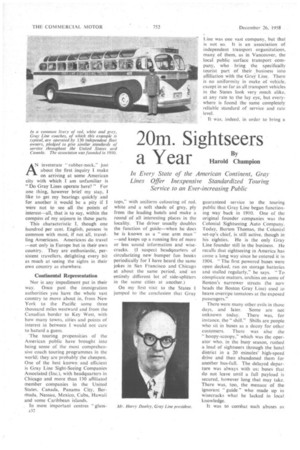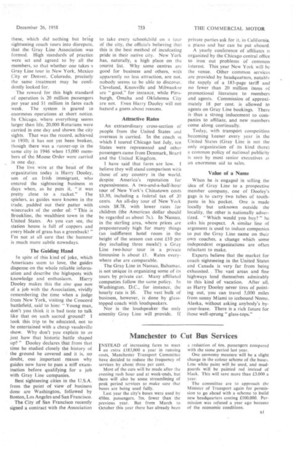20m. Sightseers
Page 34

Page 35

If you've noticed an error in this article please click here to report it so we can fix it.
a Year Harold BC'hampion
In Every State of the American Continent, Gray Lines Offer Inexpensive Standardized Touring Service to an Ever-increasing Public
AN inveterate " robber-neck," just about the first inquiry I make on arriving at some American city with which I am unfamiliar is "Do Gray Lines operate here?" For one thing, however brief my stay, I like to get my bearings quickly and for another it would be a pity if I were not to see all the points of interest—all, that is to say, within the compass of my sojourn in those parts.
This characteristic I, though one hundred per cent. English, possess in common with most, if not all, travelling Americans. Americans do travel —not only in Europe but in their own country. They are enthusiastic, persistent travellers, delighting every bit as much at seeing the sights in their own country as elsewhere.
Continental Representation
Nor is any impediment put in their way. Once past the immigration authorities you have the whole vast country to move about in, from New York to the Pacific some three thousand miles westward and from the Canadian border to Key West, with how many towns, cities and points of interest in between I would not care to hazard a guess.
The touring propensities of the American public have brought into being some of the most comprehensive coach touring programmes in the world; they are probably the cheapest. One of the best known and efficient is Gray Line Sight-Seeing Companies Associated (Inc.), with headquarters in Chicago and more than 130 affiliated member companies in the United States, Canada, Panama City, BerMuda, Nassau, Mexico, Cuba, Hawaii and some Caribbean islands.
In most important centres "glasss32 tops," with uniform colouring of red, white and a soft shade of grey, ply from the leading hotels and make a round of all interesting places in the locality. The driver usually doubles the function of guide—when he does he is known as a "one arm man —and keeps up a running fire of more or less sound information and wise cracks. suspect headquarters of circularizing new bumper fun books periodically for I have heard the same jokes in San Francisco and Chicago at about the same period, and an entirely different lot of side-splitters in the same cities at another.) On my first visit to the States 1 jumped to the conclusion that Gray
Line was one vast company, but that is not so. It is an association of independent transport organizations, many of them, as in Vancouver, the local public surface transport company, who bring the specifically tourist part of their .business into affiliation with the Gray Line. There is no uniformity in make of vehicle, except in so far as all transport vehicles in the States look very much alike, at any rate to the lay eye, but everywhere is found the same completely reliable standard of service and rate level.
ft was, indeed, in order to bring a guaranteed service to the touring public that Gray Line began functioning way back in 1910. One of the original founder companies was the Colonial Sightseeing Auto Company. Today, Burton Thomas, the Colonial set-up's chief, is still active, though in his eighties. He is the only Gray Line founder still in the business. He recalls that sightseeing in America has come a long way since he entered it in 1904. The first powered buses were open decked, ran on storage batteries and stalled regularly," he says. "To complicate matters, urchins on some of Boston's narrower streets (he now heads the Boston Gray Line) used to heave overripe tomatoes at the exposed passengers."
There were many other evils in those days, and later. Some are not unknown today. There was, for instance, the" shill." Shills are people who sit in buses as a decoy for other customers. There was also the " hoopy-scoopy," which was the operator who, in the busy season, rushed a load of sightseers through the hotel district in a 20 minutes' high-speed drive and then abandoned them for another bus-full. The delayed departure was always with us; buses that do not leave until a full payload is secured, however long that may take. There was, too, the menace of the ignorant " guide " who made up in wisecracks what he lacked in local knowledge.
It was to combat such abuses as these, which did nothing but bring sightseeing coach tours into disrepute, that the Gray Line Association was formed. High standards of practice were set and agreed to by all the members, so that whether one takes a Gray Line tour in New York, Mexico City or Denver, Colorado, precisely the same treatment may be confidently looked for.
The reward for this high standard of operation is 20 million passengers per year and $1 million in fares each week. The system is geared to enormous operations at short notice. In Chicago, where everything seems larger than life, 20,000 Rotarians were carried in one day and shown the city sights. That was the record, achieved in 1930; it has not yet been broken, though there was a runner-up in the same city in 1946 when 15,000 members of the Moose Order were carried in one day.
The live wire at the head of the organization today is Harry Dooley, son of an Irish immigrant, who entered the sightseeing business in days when, as he puts it, "it was pretty close to a racket." The spielers, as guides were known in the trade, padded out their patter with wisecracks of the order of: "This is Brookline, the wealthiest town in the United States. As you can see, the station house is full of coppers and every blade of grass has a greenback! " I'm not at all sure that the humour is much more subtle nowadays.
The Guiding Hand
In spite of this kind of joke, which Americans seem to love, the guides dispense on the whole reliable information and describe the highspots with knowledge and enthusiasm. Harry Dooley makes this the sine qua non of a job with the Association, vividly remembering the time when a judge from New York, visiting the Concord battlefield, said to him: "Young man, don't you think it is bad taste to talk like that on such sacred ground? I took this trip to be educated, not to be entertained with a cheap vaudeville show. Why don't you explain to us just how that historic battle shaped up?" Dooley declares that from that time he studied closely the history of the ground he covered and it is, no doubt, one important reason why guides now have to pass a stiff examination before qualifying for a job with Gray Line companies.
Best sightseeing cities in the U.S.A. from the point of view of business done are Washington, followed by Boston, Los Angeles and San Francisco.
The City of San Francisco recently signed a contract with the Association to take every schoolchild on a tour of the city, the officials believing that this is the best method of inculcating pride in their native city. New York has, naturally, a high place on the tourist list. Why some centres are good for business and others, with apparently no less attraction, are not. nobody seems to be able to discover. Cleveland, Knoxville and Milwaukee are "good," for instance, while Pittsburgh, Omaha and Oklahoma City are not. Even Harry Dooley will not hazard a guess about reasons.
Attractive Rates
An extraordinary cross-section of people from the United States and overseas is carried. In the coach in which I toured Chicago last July, ten States were represented and other passengers came from Denmark, Braz!1 and the United Kingdom.
I have said that fares are low. believe they will stand comparison with those of any country in the world, despite America's reputation for expensiveness. A two-and-a-half-hour tour of New York's Chinatown costs $3.30, including a federal tax of 20 cents. An all-day tour of New York costs $8.78, with lower rates for children (the American dollar should be regarded as about 7s.). In Nassau, in the sterling area, where prices are preposterously high for many things (an indifferent hotel room in the height of the season can cost £10 per day including three meals!) a Gray Line two-hour tour in a private limousine is about Li. Rates everywhere else are comparable.
The Gray Line in Nassau, Bahamas, is not unique in organizing some of its tours by private car. Many affiliated companies follow the same policy. I n Washington. D.C., for instance, the
hourly rate is $6. The vast 'bulk of business, however, is done by glasstopped coach with loudspeakers.
Nor is the loudspeaker the only amenity Gray Line will provide. If private parties ask for it, in California, a piano and bar can be put aboard.
A yearly conference of affiliates is organized by the Chicago central office to iron out problems of common interest. This year New York will be the venue. Other common services are provided by headquarters, notably the supply of a 183-page tariff and no fewer than 20 million items of promotional literature to members and agents. Commission of approximately 18 per cent. is allowed to agents on Gray Line bookings. There is thus a strong inducement to companies to affiliate, and new members come along continually.
Today, with transpart competition becoming keener every year in the United States (Gray Line is not the only organization of its kind there) a common policy of national publicity is seen by most senior executives as an enormous aid to sales.
Value of a Name
When he is engaged in selling the idea of Gray Line to a prospective member company, one of Dooley's gags is to carry two tubes of toothpaste in his pocket. One is made locally but unknown outside the locality, the other is nationally advertized. "Which would you buy?" he asks his prospect. A similar line of argument is used to induce companies to put the Gray Line name on their own coaches, a change which some independent organizations are often reluctant to make.
Experts believe that the market for coach sightseeing in the United States and Canada is very far from being exhausted. . The vast areas and fine highways lend themselves admirably to this kind of vacation. After all, as Harry Dooley never tires of pointing out, you can travel 5,000 miles from sunny Miami to icebound Nome. Alaska, without asking anybody's byyour-leave. There is a rich future for those well-sprung "glass-tops."








































































